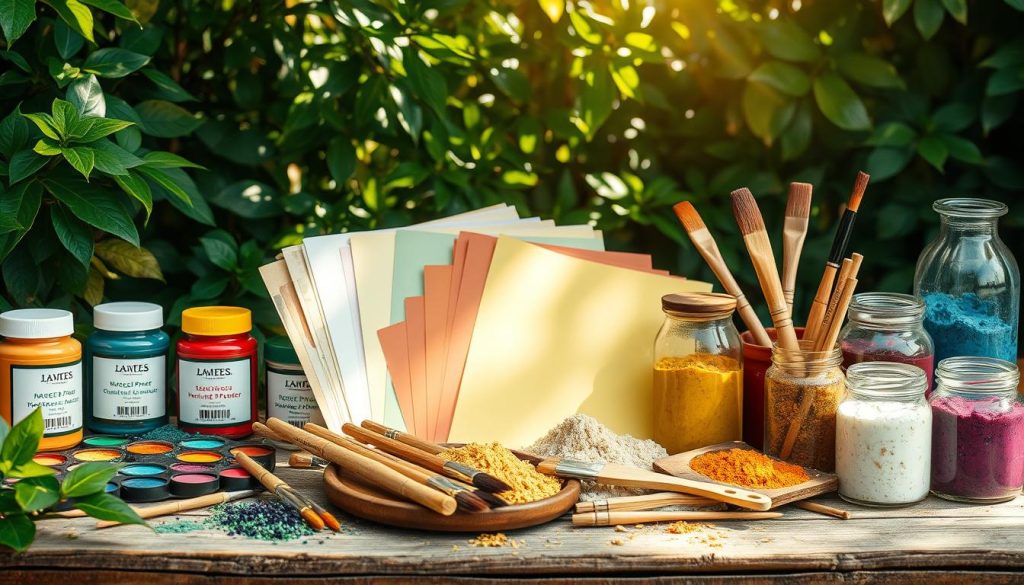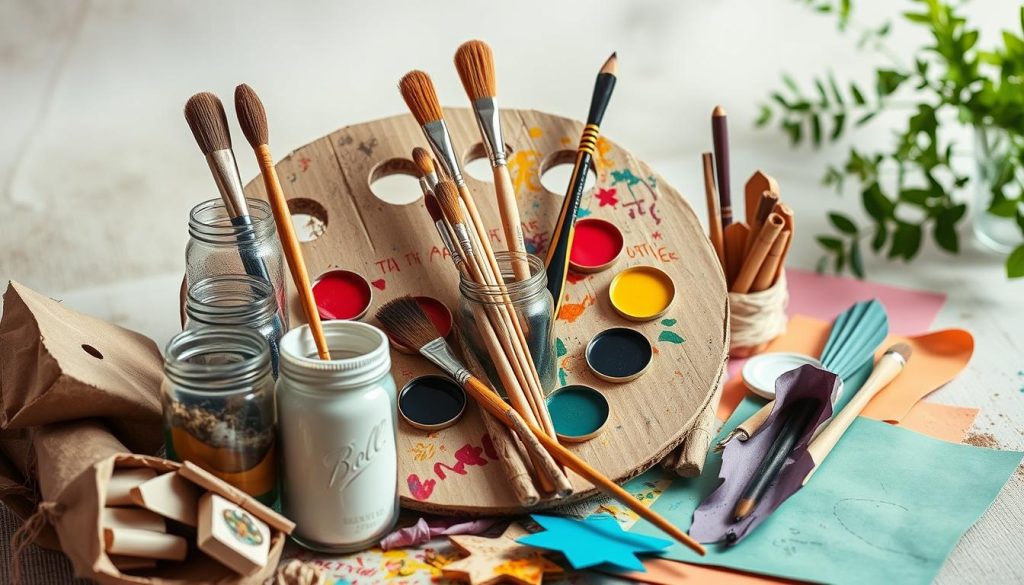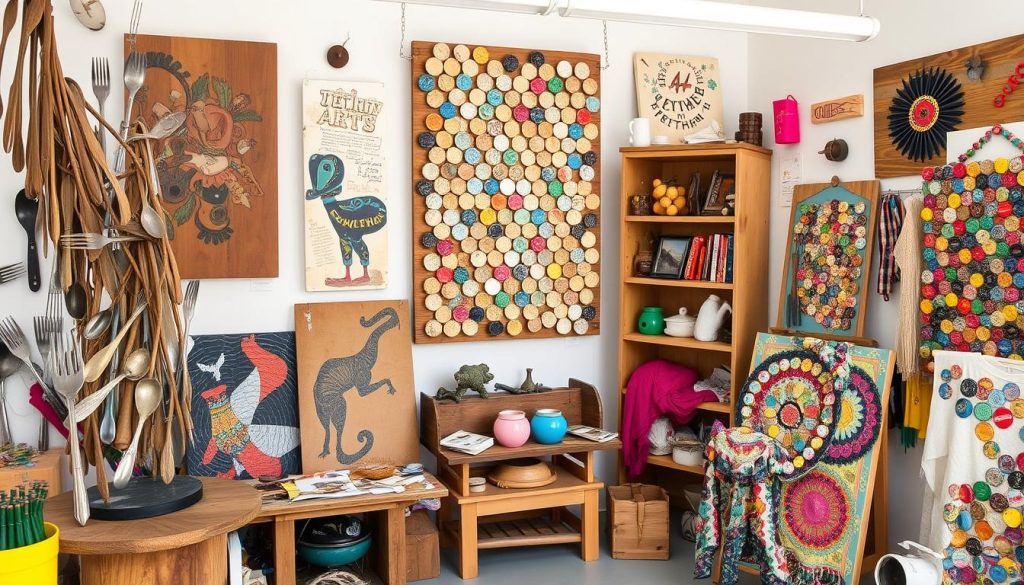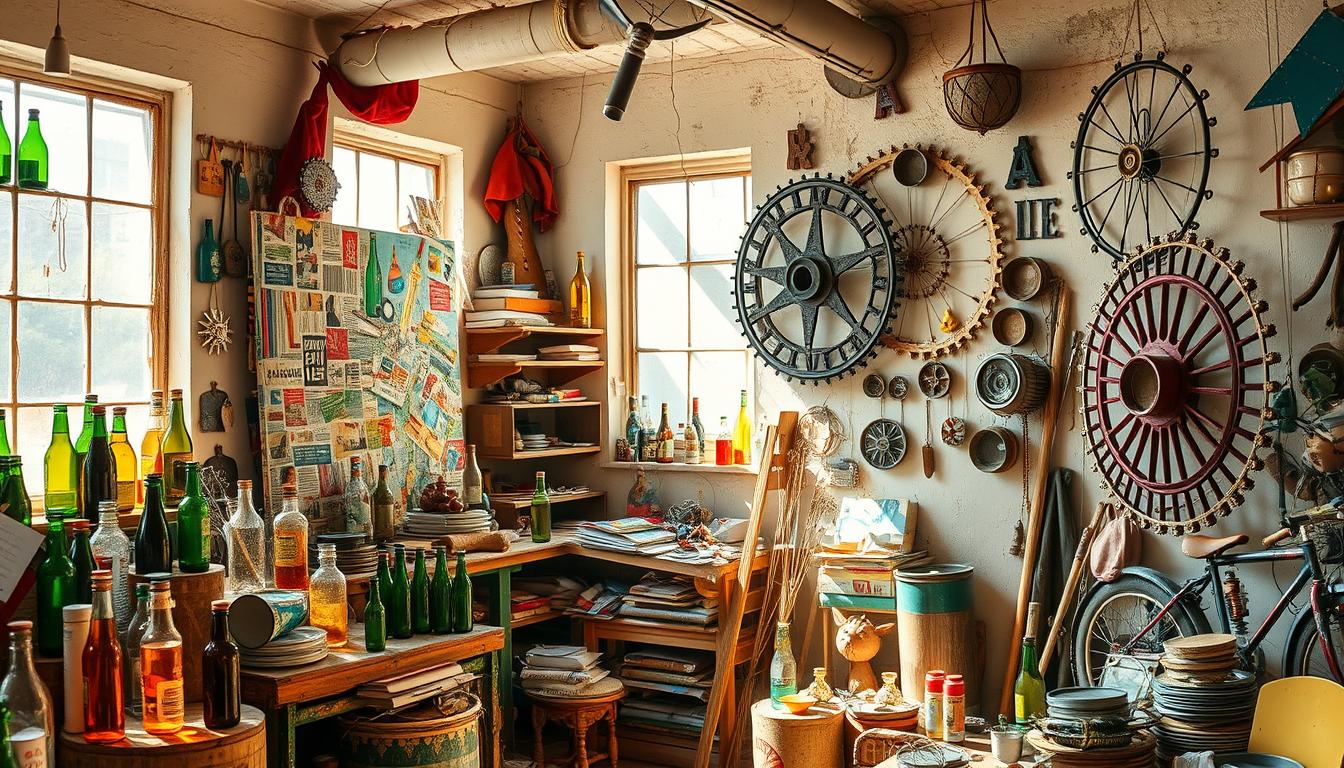I’m excited to share the world of upcycled materials for art. Here, creativity meets sustainability. Using eco-friendly art supplies is good for the planet and sparks creativity.
Upcycled materials offer endless possibilities. You can turn old clothes and fabrics into beautiful art. Or, create detailed sculptures from recycled items.
In this article, we’ll look at 10 unique ideas for upcycled art. We’ll see how eco-friendly supplies benefit both artists and the environment. Whether you’re experienced or new, upcycled materials add creativity and sustainability to your art.
What Are Upcycled Materials?
Exploring sustainable art, I’ve learned how vital upcycled materials are. They turn old items into new, useful ones. This not only cuts down on waste but also sparks creativity in artists.
Artists use many items for upcycling, like fabric scraps, plastic bottles, and wooden pallets. These materials help create unique, eco-friendly art. They show the artist’s creativity and care for the planet.
It’s key to know the difference between upcycling and recycling. Recycling breaks down materials to reuse them. Upcycling, however, makes new items from old ones. This requires a lot of creativity to give new life to discarded items.
By using recycled materials, artists make special pieces. These pieces not only reduce waste but also inspire others to think green.
Definition and Importance
Upcycled materials are crucial in sustainable art. They help artists make unique pieces while being kind to the environment. This approach also helps reduce waste and save resources.
How Upcycling Differs from Recycling
Recycling is important for saving resources and cutting waste. But upcycling is more creative and innovative. It turns old items into new, valuable ones. This way, upcycling adds value to materials that would otherwise be thrown away.
Benefits of Using Upcycled Materials in Art

Exploring upcycled materials opens up a world of benefits. Using environmentally friendly art supplies and repurposed materials is good for the planet. It also boosts creativity.
One big plus is how it helps the environment. Artists can cut down on waste by using materials that would otherwise be thrown away. This reduces their carbon footprint and supports a greener future.
Environmental Impact
Using eco-friendly art supplies and repurposed materials is good for the planet. Here’s how:
- It saves natural resources.
- It cuts down on landfill waste.
- It lowers greenhouse gas emissions.
Cost-Effectiveness
Upcycled materials can also save money. Artists can reuse materials instead of buying new ones. This means they can spend more on their art.
Creative Freedom
Lastly, upcycled materials give artists freedom to be creative. They’re not stuck with traditional supplies. This freedom lets artists try new things and make unique art.
Unique Upcycled Materials to Consider

Exploring upcycled materials is exciting. I’m eager to share unique options for your art projects. You can use old clothes, fabrics, glass bottles, and jars. These choices are endless. They help reduce waste and support sustainability.
Some of the most interesting upcycled materials include:
- Old clothes and fabrics, which can be repurposed into quilts, rugs, or even stuffed animals
- Glass bottles and jars, perfect for creating decorative vases or candle holders
- Wooden pallets and scrap wood, ideal for building shelves, tables, or other furniture pieces
- Electronic waste, such as old keyboards or computers, which can be transformed into unique sculptures or installations
Using these materials is good for the environment. It also lets you think creatively and come up with new ideas. By choosing green and reclaimed art supplies, you can make something truly special and unique.
Creative Projects Using Upcycled Materials

Exploring upcycled materials for art is truly inspiring. It shows how creativity and innovation can reduce waste and support sustainability. The variety of projects made from upcycled materials is vast and exciting.
Imagine wall art from magazine cutouts or furniture made from old doors. There are also sculptures from plastic waste that show off an artist’s skill and the need to reduce plastic waste. Using earth-friendly art supplies helps us make a difference and create unique art.
Wall Art from Magazine Cutouts
Transforming old magazine cutouts into art is a great idea. Artists arrange them in creative ways to make stunning pieces. These pieces add a personal touch to any room.
Furniture Makeovers with Old Doors
Old doors can become functional and stylish furniture like coffee tables or shelves. This project reduces waste and gives old materials a new life. It’s a perfect example of upcycled materials in art.
Sculptures from Plastic Waste
Plastic waste is a big problem, and turning it into sculptures raises awareness. These sculptures inspire viewers to think about their daily choices and their impact on the environment.
Tips for Working with Upcycled Materials
Working with eco-friendly art supplies and sustainable materials is rewarding and creative. Here are some tips for using upcycled materials:
Finding Materials
Look for materials in thrift stores, garage sales, and your own home. These places can be full of items ready to be turned into art. Be open-minded and let your creativity find unique items to transform.
Safety Considerations
When using upcycled materials, safety is key. Wear gloves and safety glasses. Follow proper handling and cleaning to stay safe and enjoy your art.
Techniques for Incorporating Different Materials
Try different techniques to mix upcycled materials in your art. Use collage, mosaic, assemblage, and mixed media. Each material’s unique texture and property can make your art stand out and be eco-friendly.
By following these tips, you can safely and confidently use upcycled materials in your art. This promotes sustainability and reduces waste. Enjoy turning the ordinary into something amazing!

